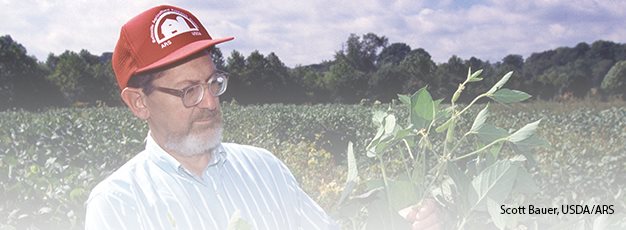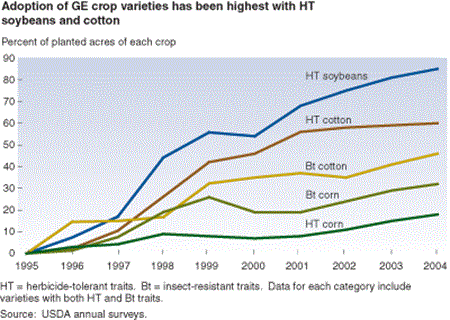Genetically Engineered Crop Varieties Gain Further Acreage Share in 2004

Genetically engineered varieties of soybeans, corn, and cotton have been available commercially since 1996. Since then, their rate of use by U.S. farmers has climbed most years, including 2004. For the most part, farmers have adopted herbicide- tolerant (HT) varieties, which help control weeds, at a faster pace than insect-resistant varieties, which help control insects.
Weeds are such a pervasive pest for soybeans, corn, and cotton that over 90 percent of planted acreage for each crop was treated with herbicides in recent years. Crop varieties with HT genes can survive certain potent herbicides that previously would have destroyed the crop along with the weeds, giving farmers who adopt HT varieties a powerful new tool to control weeds. Acreage share for HT soybeans, which reached 85 percent of U.S. soybean acreage in 2004, has expanded more rapidly than acreage shares for HT varieties of cotton and corn. Farmers’ adoption of HT soybeans has been widespread among major growing States, ranging in 2004 from 75 percent in Michigan to 95 percent in South Dakota. Acreage share for HT cotton has also expanded rapidly, reaching 60 percent in 2004. In contrast, acreage share for HT corn reached only 18 percent in 2004, but this is still an increase from 15 percent in 2003.
Insect-resistant crops contain a gene from a soil bacterium, Bacillus thuringiensis (Bt), which produces a protein toxic to specific insects. Acreage shares for Bt cotton and corn are lower than those for HT soybeans and cotton and vary much more across producing States, with adoption more concentrated in areas with high infestations of targeted pests. Farmers planted Bt cotton—which controls tobacco budworm, bollworm, and pink bollworm—on 46 percent of cotton acreage in 2004. Acreage share ranged from 13 percent in California to 86 percent in Louisiana. Bt corn, originally developed to control the European corn borer, was planted on 32 percent of corn acreage in 2004, up from 29 percent in 2003 and 24 percent in 2002. These recent increases in acreage share may be largely due to the commercial introduction in 2003/04 of a new Bt corn variety that is resistant to the corn rootworm, a pest that may be more destructive to corn yield than the European corn borer.
Adoption of Genetically Engineered Crops in the U.S., by Laura Dodson, USDA, Economic Research Service, October 2023
Pest Management in U.S. Agriculture, by Jorge Fernandez-Cornejo and Sharon Jans, USDA, Economic Research Service, October 1999


